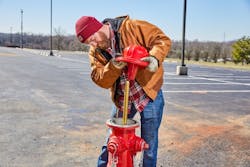The most effective way to keep a fire hydrant in working order is to have a biannual or annual testing and maintenance program. The frequency of the testing and maintenance will depend on the type of fire hydrants in the system (Dry or Wet Barrel) and the climate in which they are installed.
Here are some best practices for your maintenance program:
Exercising the fire hydrant – This will ensure the fire hydrant operates as expected. It is important that when a fire hydrant is operated, the auxiliary valve tied to the hydrant is also exercised.
Proper lubrication of the fire hydrant – Fire hydrants are typically grease or oil-filled. Follow the manufacturer’s instructions on lubrication. Without proper lubrication, corrosion can occur making the hydrant difficult or, in some cases, impossible to operate.
Fire hydrant flushing – It is important to remove any foreign material that may be inside the fire hydrant or lead line. During flushing, we have seen many obscure things appear like soda cans, tire innertubes, bathroom rugs, and chunks of wood. These items can block the fire hydrant main valve hindering the ability to open or close the hydrant.
Checking fire hydrant for standing water – This is especially important in cold climates. The presence of a high-water table or clogged drains holes can cause water to accumulate in the fire hydrant. Accumulated water can freeze causing damage to the hydrant. This inspection can be done after flushing by holding your hand over the exposed nozzle to feel for small amounts of suction. This signals that the fire hydrant is draining properly. Some fire hydrants in areas with a higher water table may have plugged drains, these need to be pumped after use.
Inspect traffic features – During the inspection, double-check that the breakaway devices are not damaged. Depending on the age and type of the fire hydrant, this feature could be breakaway flanges or breakaway bolts. Some fire hydrant models do not have a breakaway design. It is also important to inspect the fire hydrant surroundings. Make sure there are no obstructions hiding the fire hydrant, like bushes or debris, from firefighters.
Proper fire hydrant height – A fire hydrant that has the incorrect height above the groundline can have serious implications if hit by a vehicle. A hydrant that is buried too low can cause a hydrant to not break as expected during a collision and make removal of the nozzle caps difficult. Id it is buried too high, a vehicle may impact the lower barrel and can cause not only more damage to the vehicle, but also damage water piping systems.
Inspect fire hydrant for leaks – The hydrant can be pressurized to inspect for leaks. This is achieved by removing a hydrant cap and operating the hydrant a few turns. Allow the hydrant barrel to fill until a small amount is coming out of the nozzle, this allows for as much air to escape as possible. Replace the cap and fully open the hydrant. With the hydrant pressurized, all visible joints can be inspected for leaks.
Check hydrant outlet nozzle caps – Over time, corrosion can make nozzle caps difficult to remove. Remove caps during each inspection and clean them. Adding food-grade lubrication or anti-seize to the nozzle and cap threads can assist with easier operation in the future.
Record keeping of hydrant maintenance – This is important for a municipality to know which hydrants have been repaired/inspected or need to be repaired/inspected. Any issue discovered during an inspection should be repaired in a timely fashion. Fire hydrants that deemed inoperable should be black bagged or tagged to prevent accidental use and replaced or repaired as soon as possible.
Editor's Note: Scranton Gillette Communications and the SGC Water Group are not liable for the accuracy, efficacy and validity of the claims made in this piece. The views expressed in this content do not reflect the position of the editorial teams of Water & Wastes Digest, Water Quality Products and Storm Water Solutions.
